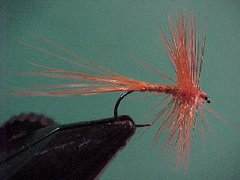{{+1}}Wet fly – hackles{{-1}}
{{start}}
Hackles and hackle fibres are used in various ways in the construction of wet flies. Whilst poorer dry fly hackle capes have traditionally been used in wet flies, over recent years, specific wet fly capes and saddles have evolved by the selective breeding of various birds.
Alternative uses of wet fly hackles
| F |
Flat over thorax hackle legsAlthough this is a nifty way of representing legs on a fly, particularly a nymph, it is not used very often. |
 |
|---|
| G |
Divided hackle egsDivided hackles are either hackles that have first been tied in beard style and then separated or are individual hackle fibres such as those in my nymph that are tied along each side of the thorax.
|
 |
|---|
| H |
Knotted hackle legsSingle and multiple hackle fibres make very realistic legs when first knotted and then tied along the side of a fly.From time to time, particularly if your tying hopper type flies, you will come across a recipe that calls for knotted hackle legs. The most common hackle used is pheasant tail and if you have big fingers like me you can find it very hard to tie the knot. If you follow the following the following process becomes much easier. |
 |
|---|
| F |
Matuka type tailsIf your looking for hackles for a matuka tail the best option is hackles a round round tip rather than a pointed tip.
|
 |
|---|
| G |
Hair tails for wet fliesThere are many different barbules or fibres used as tail material for flies.
|
 |
|---|
| J |
Split tails - hair or hackleSplit hackle tails are used for a number of types of flies particularly spinner ans mayfly representations.
|
 |
|---|
{{end}}




















